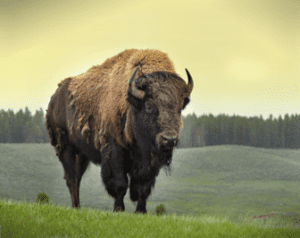TAG: GS 3: ECOLOGY AND ENVIRONMENT
THE CONTEXT: The Forest Department officials have conducted a comprehensive scientific survey over the past three months to estimate the population of the Indian Bison, also known as gaur, in the Papikonda National Park and nearby forests.
EXPLANATION:
- The survey employed a combination of camera traps and on-ground foot patrolling for accurate population estimation.
- Forest Range Officers, Range Officers, and other personnel conducted foot patrols in specific sectors to ensure a thorough count of the Indian Bison.
- The use of camera traps added a technological dimension to the survey, capturing visuals of the bison population in their natural habitat.
- According to the survey results, the estimated population of Indian Bison in the surveyed areas is 375.
- This count includes both adults and calves.
- The distribution of the population across specific regions is as follows:
- Polavaram (119 Bison): The highest count was recorded in Polavaram, indicating a significant presence of Indian Bison in this region.
- Chintur (101 Bison): Chintur follows closely with a substantial population of Indian Bison, contributing to the overall biodiversity of the area.
- Paderu (84 Bison): The survey identified 84 Indian Bison in the Paderu region, signifying a notable concentration in this particular forest area.
- Chintapalli (37 Bison): Chintapalli showed a relatively lower count, but still plays a role in sustaining the Indian Bison population in the broader ecosystem.
Geographical Coverage
- The survey covered a diverse range of forests, including those in Kukunur, Maredumilli, Rajavommangi, Kunavaram, Lakkavaram, Nillipaka, Jeebadu, Marripakala, Pedavalasa, Chintur, and V.R. Puram areas.
- This extensive coverage ensures a representative sample of the Indian Bison population across various ecosystems, contributing to a more accurate estimation.
Wildlife Conservation Significance
- The study holds significance for wildlife conservation efforts, providing crucial data on the Indian Bison population.
- The Papikonda National Park, along with the surrounding forests, emerges as a stronghold for the Indian Bison, emphasizing the importance of preserving these habitats.
- The presence of calves indicates a stable and sustainable population, essential for the long-term health of the species.
Ecological Impact and Challenges
- The Indian Bison, being a wild member of the buffalo family, plays a vital role in maintaining the ecological balance of the Eastern and Western Ghats.
- However, the report highlights that these animals, especially the males, can pose a danger to humans and may exhibit aggressive behavior.
- The need for implementing effective conservation strategies that consider both the protection of wildlife and the safety of human populations residing near these habitats has been stressed.
Papikonda National Park:
- It is located in Andhra Pradesh.
- The area is mostly is inaccessible with hilly terrain with high slopes & valleys.
- The area plays a key role in high precipitation and the consequent origin of various small streams and rivulets which drain and enrich the perennial River Godavari.
- The park exists in the Eastern Ghats which is known for rich floristic diversity with more than 2531 species under 700 genera and 125 families constituting about 13% of the flowering plants of India.
- The moist deciduous forests have maximum number of endemic species (173 taxa), followed by dry deciduous (121 taxa).
- A unique dwarf breed of goat known locally as the “kanchu mekha” originates in this region.
- The national park has been recognized as an Important Bird and Biodiversity Area by BirdLife International.
- An Important Bird and Biodiversity Area (IBA) is an area identified using an internationally agreed set of criteria as being globally important for the conservation of bird populations.
- IBA was developed and sites are identified by BirdLife International. There are over 13,000 IBAs worldwide.
- These sites are small enough to be entirely conserved and differ in their character, habitat or ornithological importance from the surrounding habitat.
Bison:
- The gaur also known as the Indian bison, is a bovine native to South Asia and Southeast Asia and has been listed as Vulnerable on the IUCN Red List since 1986.
- The global population was estimated at a maximum of 21,000 mature individuals in 2016, with the majority of those existing in India.
- It is the largest species among the wild cattle and the Bovidae.
- The domesticated form of the gaur is called gayal (Bos frontalis) or Mithun.
- They prefer evergreen forests and moist deciduous forests. However, they can survive in dry deciduous forests also.
- They are not found in the Himalayas with an altitude greater than 6,000 ft. They generally stick to the foothills only.
- The Indian Bison is a grazing animal and generally feeds in the early morning and in the late evenings.


